

 Protecting our Environment is a global issue, but how we manage the dangers and defy the 'point of no return' is the subject of many passionate arguments.
Protecting our Environment is a global issue, but how we manage the dangers and defy the 'point of no return' is the subject of many passionate arguments.
Carbon neutral by 2050?
Not nearly soon enough say many; 'particularly young activists' but how do we go about arresting the journey to environmental oblivion?
The real problem is the success of 'homo sapiens' - the exponential rise in global population is surely the single most influence on 'where we are today'
Simply: there are too many people on this planet!
How we manage protecting the Environment is a global issue and redressing the damage has no easy answer.
According to the most recent data from 2012 provided by the U.S. Energy Information Administration, the top five countries that produce the most CO2 are China, the United States, India, Russia and Japan.
Global emissions can be allocated to human activities in various ways. One of the most granular analyses is this one from the World Resources Institute (WRI), which breaks down total global emissions from 2005 into the following headline sectors:
Energy
- Electricity & heat (24.9%)
- Industry (14.7%)
- Transportation (14.3%)
- Other fuel combustion (8.6%)
- Fugitive emissions (4%)
Agriculture (13.8%)
Land use change (12.2%)
Industrial processes (4.3%)
Waste (3.2%)
![]() The English Apple Man does not pretend to have the answers; what occurs to me though is the need to feed people and how we maximise food production without further damaging the world we live in.
The English Apple Man does not pretend to have the answers; what occurs to me though is the need to feed people and how we maximise food production without further damaging the world we live in.
Many look back 'starry eyed' to the less stressful world of our Grandparents, when food production, transportation and retailing was driven by simpler technology!
But: Life then was not all rosy. The poor were very poor. Saving the environment 'not on the agenda'
THE future of British trade after Brexit is shrouded in uncertainty. It is an unprecedented process, so it is hard to know where to 'look for clues' as to how it may work out. One possibility is a country whose trading patterns were perhaps more disrupted than any other's by Britain's accession to the European Economic Community (EEC) in 1973: New Zealand.
Just as Brexit is likely to mean the end of British access to the single market, so "Brentry" ended New Zealand's preferential access to the "mother country". In 1961, when Britain first announced its intention to join the EEC, it took about half of New Zealand's exports - a similar proportion to the EU's share of British exports today.
Following fruit growers and other horticultural producers in New Zealand is always educational. When the lifeline to UK markets was 'cut off' by UK entering the EU (Common Market) leaving NZ high and dry, NZ had to face the future without the umbilical cord and become commercially competitive in global markets. A country that survives on export of high quality produce is a model worth taking note off!
Today - Balancing food production with environmental sustainability is a key element in future food production.
 Below: Mike Chapman, Chief Executive Horticulture New Zealand comments on his blog.
Below: Mike Chapman, Chief Executive Horticulture New Zealand comments on his blog.
"Climate change mitigation, new environmental regimes and more restrictive access to water will, in the next few years, have a major impact on the primary sector in New Zealand.
The outcome being sought is environmental sustainability and the reduction of our greenhouse gases. What will be needed however is a balanced approach that not only achieves environmental sustainability but also financial and social sustainability.
It is an essential fact of business that to survive, you need to make a reasonable living. If our rural businesses cannot remain profitable then there will be a massive social impact as they go out of business, stop producing food and employing people. This will not only impact the rural communities but also urban communities that rely on the primary sector to feed them. There would also be an increase in demand for urban housing.
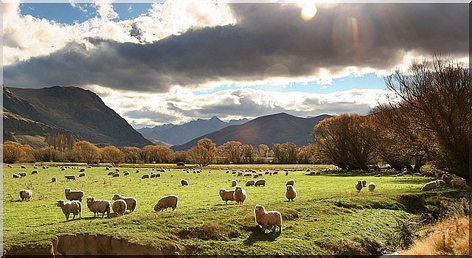 The primary sector is being asked to make significant changes in how just about everything is done on-farm. To meet some of the climate and environmental requirements there will most likely need to be some land use change into trees and horticulture.
The primary sector is being asked to make significant changes in how just about everything is done on-farm. To meet some of the climate and environmental requirements there will most likely need to be some land use change into trees and horticulture.
But for land use to be effective it needs to be supported by the farmer getting scientifically sound advice about what to change their land use to, how to do it and, there needs to be a market to successfully sell the produce to. In addition, with each different type of land use there are different water, nutrient, labour and infrastructure requirements. All of this comes at a cost and are complicated and risky.
The next issue is that council requirements for land use change can either be an enabler or an inhibitor.
Restrictions on water and nutrient access have the potential to inhibit land use changes and frustrate climate change mitigation and environmental sustainability.
Critically, they will certainly impact New Zealand's ability to feed itself, taking vegetables as just one example.
 Urbanisation, the spread of life-style blocks and council regulations both taking away growing land and, making it illegal to grow vegetables are a very real threats to our ability to feed ourselves with healthy locally grown food.
Urbanisation, the spread of life-style blocks and council regulations both taking away growing land and, making it illegal to grow vegetables are a very real threats to our ability to feed ourselves with healthy locally grown food.
The answer to this conundrum is to first recognise that we need to make provision for vegetables to be grown across the country.
The second, and most important factor, is for the Government and councils to work in partnership with industry so that as a country we can achieve climate change mitigation and environmental sustainability.
This has to be achieved while ensuring that the primary sector remains profitable and able to feed New Zealand and earn valuable overseas income.
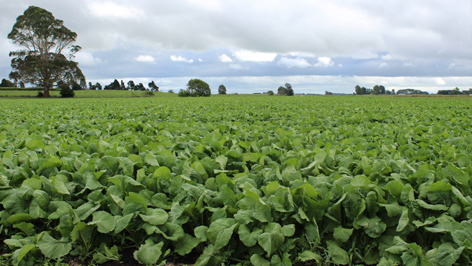 This will not be an easy task as the various policies and regulations that both central government and councils are working on are more often than not mutually exclusive. For example, if climate change mitigation will require land use change, then we need all other policies and regulations to assist and enable that.
This will not be an easy task as the various policies and regulations that both central government and councils are working on are more often than not mutually exclusive. For example, if climate change mitigation will require land use change, then we need all other policies and regulations to assist and enable that.
If the land use change requires different quantities of water and different nutrient regimes for the new crop to be economically sustainable, then the government and council regulations needs to permit that. It would certainly frustrate climate change mitigation, if land use change was not permitted under government and council rules. This is not a dire predication, it is a reality today in a number of regions, especially when it comes to growing vegetables where quality land and regulatory permission to grow vegetables is non-existent.
Now is the time, before it is too late, for rampant urban and lifestyle block growth to stop and for high quality land close to cities to be retained for feeding New Zealand. Feeding New Zealand and permitting urban and lifestyle development are policies that need to be urgently aligned rather than being mutually exclusive as they are today.
The climate change advantages of growing on high quality soils are numerous - less fertiliser is required and there is less trucking to the adjoining city. One of the disadvantages of growing next to cities is that city's pollution of the environment and aquifers. So not only does the rural sector need to work on environmental sustainability, but so does urban New Zealand and very urgently. Then in addition to saving the high-quality soils for growing high quality healthy food, the regulations need to enable growing food.
So, if we are going to successful tackle the challenges facing the whole country Government and council regulations and policies need to line up and be cohesive. We need to move away from mutually exclusive policies as they will prevent New Zealand reaching its targets. If land use change is needed, then all policies need to support sensible land use change. This lack of cohesion is in my view the single biggest road-block to New Zealand's sustainable future.
Mike Chapman, Chief Executive
Following on a report in Farmers Weekly
Food prices in Britain are among the lowest in Europe, according to an EU Commission survey.
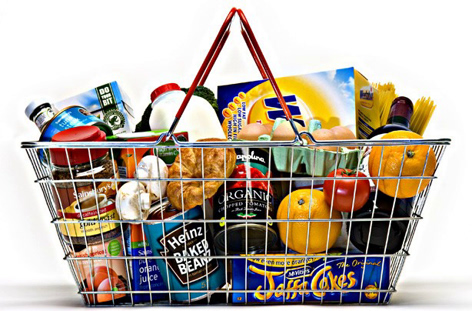 Overall, the survey shows prices in the UK for 440 key products are well below the EU average. Milk, cheese and eggs in the UK recorded the 26th lowest prices out of the 28 member states.
Overall, the survey shows prices in the UK for 440 key products are well below the EU average. Milk, cheese and eggs in the UK recorded the 26th lowest prices out of the 28 member states.
Only the less-developed economies in former Eastern Bloc countries such as Hungary, Bulgaria and Romania recorded lower overall average prices in the survey.
When compared with the more affluent, long-standing member states, UK prices are rock bottom (see panel).
Denmark had the highest price level for a basket of comparable foods in 2018.
The Danes paid 130% of the EU average price - almost twice as much as the lowest-cost grocery bill in Romania at 66% of the average.
Other high-cost nations were Luxembourg and Austria, both 125% above average, followed by Ireland and Finland at 120% and Sweden 117%.
At the opposite end of the scale, the lowest price levels were seen in Romania (66%), Poland (69%), Bulgaria (76%), Lithuania (82%), Czech Republic (84%) and Hungary (85%).
Britain comes next at 86%.
A Food and Drink Federation (FDF) spokesman said that while the highly concentrated retail market and strong competition between suppliers meant UK consumers benefited, farmers and manufacturer margins were squeezed.
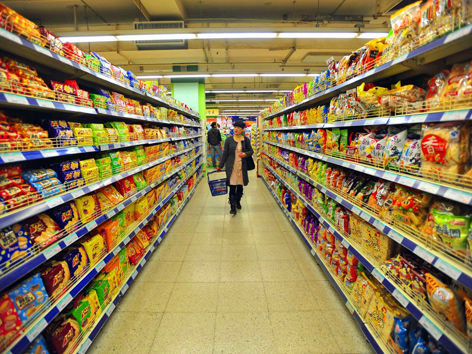 "The price war among UK grocery retailers presents major challenges for manufacturers and farmers alike.
"The price war among UK grocery retailers presents major challenges for manufacturers and farmers alike.
"The FDF's most recent business confidence survey (Q1 2019) showed 51% of manufacturers are experiencing shrinking profit margins."
There are concerns this could threaten the ability of manufacturers to invest in innovation and new product development.
"This challenge is further increased across the whole food chain as a result of the enormous cost and disruption of preparing for a potential no-deal Brexit."
Gareth Morgan, head of policy for farming and land use at the Soil Association, said: "The news that UK retail food prices are on average some 20% less than the average of the EU prices and for milk, cheese and dairy are close to the bottom of the EU price rankings bears testimony to the power of UK retailers to both drive efficiencies in store and to their power within UK and global supply chains.
"For farmers this is challenging. What is relevant to farmers is farmgate price and the proportion of retail price this represents."
Mr Morgan added that for many products, the difference between farmgate and retail prices are smaller than in other EU countries, further exacerbating the position of UK farmers.
"For some, moving to a direct-to-customer model represents an option to supply people who want to know where their food has come from and who are prepared to pay a fair price for what they eat."
Click on Farmers Weekly for more information.
An interesting self sufficiency graph demonstrated by Berry Gardens CEO Jacqui Green at the recent EKFS Soft Fruit visit to Clockhouse Farm, shows the level of 'self sufficient' (home grown produce) in the UK today. While some crops cannot be 100% 'home grown' - Asparagus for example, root crops (highly mechanised) are close to 100%. The success of UK 'Berry Production' over the last 20 years is clear, but will depend on available harvest workers if the upward curve in home grown berries continues.
Largest ever tractor delivery for AC Goatham & Son
AC Goatham & Son has taken delivery of its largest ever order of new tractors, when 20 New Holland vehicles supplied by Haynes Agricultural Ltd were delivered to Flanders Farm, Hoo this month.
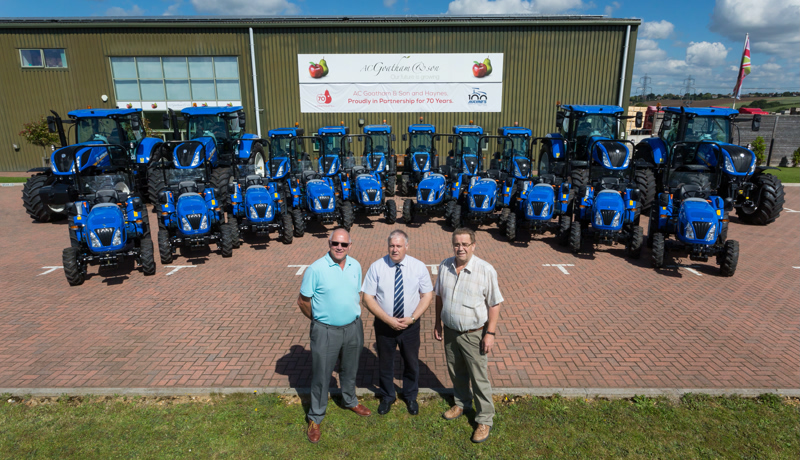
The new vehicles will have a range of roles in the orchards and around the 28 farms of the UK's largest apple and pear grower, bringing greater technology, innovation and efficiency to their existing fleet of vehicles.
The delivery consisted of:
- Four T7-245 for heavy duty haulage around the farms
- Six T4-100N for spray and orchard operations
- Ten Boomer 35 tractors for picking train operations
Steve Everard, Director at AC Goatham & Son comments: "We are delighted to be taking delivery of these new vehicles from Haynes who have been supplying our business over the last 70 years. These vehicles bring with them a number of opportunities to integrate the technology of our farm operations, linking more closely the work of the driver, farm managers and growing teams. They will also play a vital role during our busy harvest period, when it is essential to get fruit quickly from the field and into cold storage."
Jeremy Cloude of Haynes Agricultural Ltd comments: "We are delighted to once again work with our long-standing customers, AC Goatham & Son and to fulfil this which is their largest single order of tractors in their 70 year history. These vehicles are fuel efficient and equipped with a whole range of features which make it easier for the driver, whilst providing information back to their farm team.
The technology in these vehicles means there is much greater precision and accuracy of a number of operations and they are fast, powerful and reliable during the busy harvest periods. We have been selling New Holland tractors for 100 years this year and it is fantastic to see how they have developed to support modern farming businesses such as AC Goatham & Son."
Sorry for the eclectic mix in this week's EAM Journal - until next week
Take care
The English Apple Man